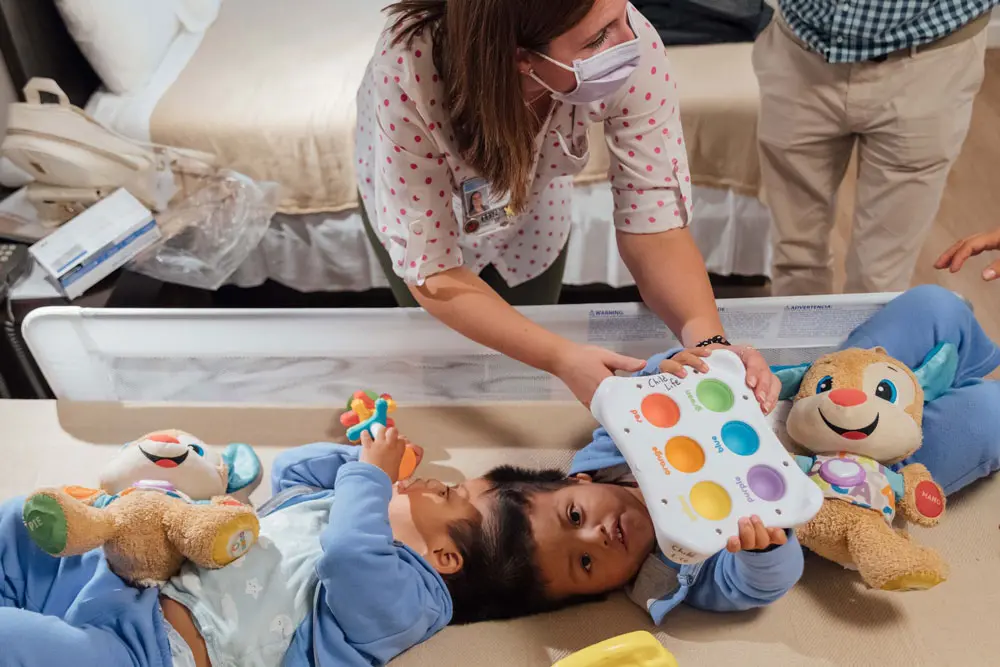Aug 24

Alumnus is key part of rare surgery
News media from around the world have shared the story of the successful separation of craniopagus twins Pedro and Augusto at Dayton Children’s Hospital.
Robert Lober, M.D., a pediatric neurosurgeon at the hospital, led the team that planned and performed a series of four operations over the course of two years to separate the twins.
Before Dr. Lober could get started though, he called on a NEOMED alumnus to help determine if the separation was even possible.
The twins shared venous circulation. “One child’s blood vessels drain into the other’s,” Dr. Lober explained in a documentary about the separation surgery. He needed someone on the team with specific expertise in that area.
“If there’s one guy you want in this surgery, it’s Dr. Patel,” said Dr. Lober in the film. “He is an extremely important part of this team because of his expertise with blood vessels in the brain.”

That “Dr. Patel” is Akil Patel, M.D., a board-certified neurosurgeon at Kettering Health Main Campus, and a 2010 graduate of NEOMED’s College of Medicine. He has dual training in complex cerebrovascular neurosurgery and endovascular neuroradiology. He usually works with adults and older teens.
“Dr. Lober was the guiding ship [for the medical team],” Dr. Patel said. “He realized he needed to look at the vascular anatomy and determine how much of the vascular system they shared.”
The challenge was unlike anything Dr. Patel had yet experienced in his career.
“I had to think three dimensionally throughout this process.”
Traditional techniques — cerebral angiograms to track blood flow, CT scans and MRIs, for instance – were used to develop simulations and get a better sense of the issues they were facing before surgery. The team trained in multiple code simulations and scenarios.
Newer technology, such as 3D imaging and computer simulations, were also vital to the planning. “We worked with a 3D printing company in the area and sent them our models and angiograms,” Dr. Patel said. The resulting 3D scans gave the team a clearer idea of what they were facing.
The separation surgeries “had so many pieces,” said Dr. Patel. “We had to determine the technical feasibility. Then all the planning, all the time, the strain and stress on the system and the team. It was very time consuming. It took time away from my normal practice and time away from my family. But it was all very well spent. I would do it again in a heartbeat”
There are an estimated 50 craniopagus twins born each year and only 30% survive more than a few months. Pedro and Augusto had already beaten the odds when they arrived in Dayton from their native Guatemala at age three. They returned home in June 2023 at age five, after the successful separation and recovery.
“The key was understanding this was really a marathon,” Dr. Patel noted about the separation. “This is, and probably always will be, the most interesting and most complicated case in my career.”
He credits his medical school training at NEOMED and residency at University of Maryland with providing the tools, skills and mindset needed to be able to contribute to the surgical team in such a meaningful way.
“NEOMED gave me the medical knowledge, but it also gave me a sense of resiliency. You can understand anatomy and pathology, but it takes more than that,” he noted, explaining how his profession often requires some creative thinking. “Just because a peg fits in the hole, doesn’t mean it’s the right option.”
Watch the documentary connected: the seemingly impossible separation of Pedro and Augusto (video is age restricted due to graphic images of a medical procedure)


